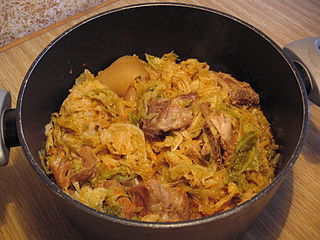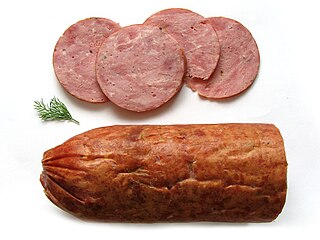Sibiu Salami, also known as Salam de Sibiu, is a Romanian variety of salami made with pork meat, pork fat, salt and condiments. In 2016, the Salam de Sibiu has been registered as a protected geographical indication (PGI) product in the European Union. [1]
In 1885, an Italian named Filippo Dozzi emigrated to Romania to work as a bricklayer. Originated from north-eastern Italy (Frisanco), Filippo Dozzi moved with his wife near Piatra Arsă's quarry in the former village of Poiana Țapului. [2]
Besides being a bricklayer, Dozzi had also a passion for sausages. He noted that weather conditions of Sinaia were favorable for the production of dry sausages. In 1910, Dozzi decided to buy a building in Sinaia that housed a restaurant, a wine cellar and a hotel, where he founded his company called Întreprinderea Individuală Filippo Dozzi (The Individual Enterprise Filippo Dozzi). Production of salami started and became quickly a success and a luxury product. Dozzi began selling his sausage under the name of salam de iarnă (winter salami), and for exports in the Austro-Hungarian Empire was affixed the stamp "Customs of Sibiu". Thus, the product became known as Salam de Sibiu. The name winter salami was used only in Romania and Hungary, though the Hungarian winter salami was different from the Sibiu Salami.
Before his death in 1943, Filippo Dozzi confided to his sons, Antonio and Giuseppe, the secret of Sibiu Salami. They continued the work of their father until the nationalization of the company by the Communist regime. [2]
At the same time, Josef Theil, a winter salami producer from Mediaș, opened in 1922 a second factory in Sibiu (as the "Theil & Co. A.G. Salami und Selchwarenfabrik") and started producing a variant of salami named "Veritabilul salam de Sibiu" ("The real Sibiu salami"). [3] [4]
Between 1948 and 1954, the Communist government nationalized both companies. [4] [5] The state company, named Întreprinderea pentru Industrializarea Cărnii (Enterprise for the Industrialization of Meat ), continued the production, with first deliveries of Sibiu Salami abroad being made in the 1950s. [4] In 1963, the Sibiu factory (which was producing the Sibiu Salami at its subsidiary in Mediaș) registered the trademark Salam de Sibiu. [4] Besides Sinaia and Mediaș, between 1975–1976, more "production units" were established in Bacău, Galați, and Salonta for the manufacturing of Sibiu Salami. In the 1980s, 90% of the production (40-50 tons per month) was exported to Austria, West-Germany, Czechoslovakia, Israel, Belgium, Sweden, and the Soviet Union. [5] [6]
Nowadays, the Sibiu Salami is produced in Sinaia, Bacău, Călărași, Feldioara, Filipeștii de Pădure and Sibiu. [7] In 2014, more than 3,000 tons were produced. [8]

Mortadella is a large Italian sausage or luncheon meat made of finely hashed or ground cured pork, which incorporates at least 15% small cubes of pork fat. It is traditionally flavoured with black pepper grains, but modern versions can also contain pistachios or, less commonly, myrtle berries. The sausage is then cooked.

A sausage is a type of meat product usually made from ground meat—often pork, beef, or poultry—along with salt, spices and other flavourings. Other ingredients, such as grains or breadcrumbs, may be included as fillers or extenders.

Hungarian or Magyar cuisine is the cuisine characteristic of the nation of Hungary, and its primary ethnic group, the Magyars. Hungarian cuisine has been described as being the spiciest cuisine in Europe This can largely be attributed to the use of their piquant native spice, Hungarian paprika, in many of their dishes. A mild version of the spice, Hungarian sweet paprika, is commonly used as an alternative. Traditional Hungarian dishes are primarily based on meats, seasonal vegetables, fruits, bread, and dairy products.

Salami is a cured sausage consisting of fermented and air-dried meat, typically pork. Historically, salami was popular among southern, eastern, and central European peasants because it can be stored at room temperature for up to 45 days once cut, supplementing a potentially meager or inconsistent supply of fresh meat. Countries and regions across Europe make their own traditional varieties of salami.

Mediaș is the second largest town and municipality in Sibiu County, Transylvania, central Romania.
Romanian cuisine is a diverse blend of different dishes from several traditions with which it has come into contact, but it also maintains its own character. It has been mainly influenced by Turkish but also a series of European cuisines in particular from the Balkan Peninsula and Hungarian cuisine as well as culinary elements stemming from the cuisines of Central Europe.
Serbian cuisine is a Balkan cuisine that consists of the culinary methods and traditions of Serbia. Its roots lie in Serbian history, including centuries of cultural contact and influence with the Greeks and the Byzantine Empire, the Ottomans, and Serbia's Balkan neighbours, especially during the existence of Yugoslavia. Historically, Serbian food develops from pastoral customs that involved the keeping of sheep in mountain highlands, in a climate and regional context that favoured animal husbandry over vegetable farming; Serbian food is therefore traditionally richer in animal products and basic grains—corn, wheat and oats—than fresh vegetable dishes. Following the abandonment of widely practiced pastoral lifestyles, Serbian food emerged through the Middle Ages heavily dependent not on lamb or mutton, but on the keeping of pigs for the annual cull and the production of various cured meats, such as sausages, bacon and ham products.

Hungarian sausages are sausages found in the cuisine of Hungary. Hungary produces a vast number of sui sausage types. They may be boiled, fresh or dried, and smoked, with different spices and flavors, "hot" or "mild". Many were influenced by their neighbors and brethren.

Chocolate salami is an Italian and Portuguese dessert made from cocoa, broken biscuits, butter and sometimes alcohol such as port wine or rum. The dessert became popular across Europe and elsewhere, often losing alcohol as an ingredient along the way.

Winter salami is a type of Hungarian salami produced according to a centuries-old tradition. Made from Mangalitsa pork and spices, winter salami is cured in cold air and smoked slowly. During the dry ripening process, a special noble-mold is formed on the casing surface.
Pick Szeged is a Hungarian company that produces a variety of meat products, most notably Winter salami. It was founded in 1869, and remains based in Szeged, Hungary.
Meat Products of India Ltd (MPI) is a major Indian meat processing, packaging, and distribution company based in Edayar, Koothattukulam in the district of Ernakulam, Kerala.

Lombard cuisine is the style of cooking in the Northern Italian region of Lombardy. The historical events of its provinces and of the diversity of its territories resulted in a varied culinary tradition. First courses in Lombard cuisine range from risottos to soups and stuffed pasta, and a large choice of second course meat or fish dishes, due to the many lakes and rivers of Lombardy.
ASTRA Arad, also known as Întreprinderea de Vagoane Arad (IVA), is the name of a group of industrial engineering and rolling stock companies originated in Arad, Romania. Operating as a single entity until 1996, the company then split into other independent companies, Astra Vagoane for freight cars production, Astra Vagoane Călători for passenger coaches and trams, and Astra Bus for bus and trolleybus manufacturing.

Ham sausage is a sausage prepared using ham and other ingredients, the latter varying by location. It is a part of the cuisines of China, Germany, Poland and the United States. Ham sausage is a mass-produced food product.

Gavrilović is a Croatian food processing company specializing in meats such as sausages and salami. The company is based in Petrinja, Croatia and can trace its history there as far back as 1690.

Salame ticinese is a variety of salami originating in Ticino, the southernmost region of Switzerland. It is characterized by coarsely ground meat and it is often made into small sausages, called salametti. It is an emblematic air-dried cured pork meat of Ticino, along with prosciutto crudo and coppa. These are referred to as salumi.